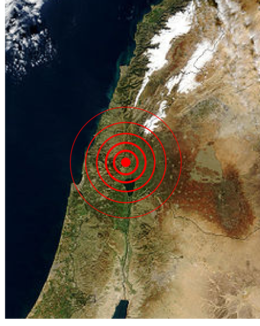Galilee earthquake of 1837
 |
|
| Date | January 1, 1837 |
|---|---|
| Duration | 20 seconds |
| Magnitude | 6.25–6.5 ML 7.0 Ms 7.0–7.1 Ms |
| Epicenter | 33°00′N 35°30′E / 33.0°N 35.5°E |
| Areas affected | Ottoman Syria |
| Max. intensity |
MSK VII–VIII EMS-92 VIII |
| Casualties | 6,000–7,000 |
The Galilee earthquake of 1837, often called the Safed earthquake, shook the Galilee on January 1 and is one of a number of moderate to large events that have occurred along the Dead Sea Transform (DST) fault system that marks the boundary of two tectonic plates; the African Plate on the west and the Arabian Plate on the east. Intensity assessments for the event were VIII (Damaging) on the Medvedev–Sponheuer–Karnik scale and VIII (Heavily damaging) on the European Macroseismic Scale.
A 1977 assessment of the event that was published in the Bulletin of the Seismological Society of America had the epicenter just north of the city of Safed and the magnitude of 6.25–6.5, but in 1997 seismologist Nicholas Ambraseys argued that the event may have been more substantial. The event was well-documented by the nineteenth-century missionary, archaeologist, and author William McClure Thomson. The region in which the earthquake occurred was part of the Ottoman empire but at the time it was under control of the Egyptians who were occupying after seizing it during conflict.
William McClure Thomson arrived in Beirut in 1833 for missionary work and was in the area at the time of the earthquake. He wrote, in fine detail, of the damage and personal tragedies he witnessed during his travels in the book The Land and the Book, Or, Biblical Illustrations Drawn from the Manners and Customs, the Scenes and Scenery of the Holy Land. The book was published in 1861 and remained a best seller through much of the nineteenth century. In the region, the Egyptians (led by Ibrahim Pasha of Egypt), had recently succeeded in overpowering the Ottomans and gained control of Syria during the Egyptian–Ottoman War (1831–1833). During his time in the area Thomson was locked up with charges of spying. The Egyptians were ultimately flushed from the region by Turkey.
...
Wikipedia
